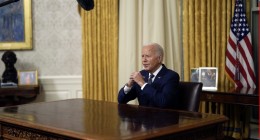As commuter buses and trains ran nearly empty at the height of the Covid-19 pandemic, the federal government stepped in with $69.5 billion in relief funds.
It was about five times the federal support for transit approved for 2019, and it is credited with rescuing public transit and saving more than 50,000 jobs in the United States.
“It was really a lifeline for the industry for Congress to step up and provide those resources,” said Paul Skoutelas, president and chief executive of the American Public Transportation Association. But, he added, “Those dollars have essentially run out.”
With ridership still lagging and the prospects for mass transit again uncertain, the health of large transportation agencies around the county could hinge, in large part, on how much aid and in what form the federal government can supply.
“The stakes are high,” said Lindiwe Rennert, a senior research associate at the Urban Institute. “We’re really talking service or no service. For some agencies, it is at that point.”
Already Feeling Squeezed
Transportation agencies around the country are already feeling the pressure.
The three transit operators serving the Chicago region are anticipating a deficit of more than $700 million by 2026, and riders could face service reductions of 40 percent or more without additional funding, according to the Chicago Metropolitan Agency for Planning.
New Jersey Transit, the nation’s third largest transit system, announced in January that it planned to raise fares by 15 percent on July 1 and, after that, by an additional 3 percent annually. The agency received $4.4 billion in federal aid during the pandemic, but more than 80 percent of that money has been spent.
Some agencies like the Maryland Department of Transportation, have received a one-time allocation of money from the state to restore funding for key transit services. But the department projects revenue is expected to grow by 1 percent annually while operating costs grow by 7 percent.
The Washington Metropolitan Area Transit Authority, which serves Maryland, Virginia and the District of Columbia, in December released a budget that predicted “an unrecognizable Metro” because of service cuts. The agency said 41 Metro lines would have reduced service, 67 of 135 bus lines would be cut and more than 2,200 people out of about 13,000 staff members would be laid off.
In late April, Metro approved a $4.8 billion capital and operating budget after receiving additional funding from its jurisdictions, avoiding major service cuts. But riders will face a fare increase of 12.5 percent, and since the agency does not have a sustainable funding source officials will face similar challenges the next fiscal year.
“This budget crisis, fiscal cliff, has happened multiple times,” Randy Clarke, general manager and chief executive of Metro, said after a board meeting in March, “but the magnitude this time is just not comparable.”
From Reagan to Biden
It’s not as if federal transit aid has completely dried up.
The Biden administration provided landmark support for transit through the 2021 infrastructure bill. It put $1.2 trillion toward infrastructure projects, with $108 billion specifically for transit.
But even such a large amount of money was not enough to address decades of funding restrictions, including a key development in the 1980s. When former President Ronald Reagan was in office, he pushed for reductions in federal spending, arguing that state and local governments or private businesses would be better suited to take on some of those responsibilities.
And in the late ’90s, Congress eliminated federal operating assistance, which covers salaries, for agencies in areas with populations larger than 200,000 people, but kept it available in smaller communities, which often have economies that cannot afford those extra costs. Larger areas can get money only for capital projects, which made the Covid-19 relief funds — which did cover operating expenses — unique.
“I’ve always felt like that is the wrong dividing line, and it results in some really weird outcomes,” said Beth Osborne, director of Transportation for America, an advocacy organization for safe and convenient transit. “There are areas that will be building things where they can’t afford to operate what they already have.”
The Biden administration has continued to push for more operating funds for transit. And, important, its proposed budget for the 2025 fiscal year calls for larger transit agencies to be allowed to use federal funding for operations for a year. (The administration’s budget request for the current fiscal year also included language asking for that change, but it was not approved, and Congress has yet to decide on the new request.)
“Looking just at these last couple of years where, even though you have very deep ridership losses initially and very slow recovery, transit agencies have basically been able to maintain their service overall,” said Nicholas Dagen Bloom, an urban policy and planning professor at Hunter College in New York City. “So that gives you a sense of the power of what federal operating support could be.”
Lawmakers have until the end of September to agree on a new spending plan to fund transportation in the 2025 fiscal year, but they are unlikely to be able to strike a deal in an election year, transit experts say. Most likely, the current spending levels will stay in place until the next Congress, which begins in January. Congress may also start considering the country’s next five-year infrastructure bill in 2025.
“Transit agencies are seeing unprecedented shortfalls on the operating side,” Veronica Vanterpool, acting administrator for the Federal Transit Administration, said in an interview. “Congress does need to act on what the president’s proposals have been.”
Polly Trottenberg, deputy secretary at the Department of Transportation, said the Covid-19 relief funds and the bipartisan infrastructure bill were the largest support for transit the country had seen.
But despite major bipartisan efforts to approve the 2021 bill and the funds, experts are skeptical about the prospects for Mr. Biden’s transit agenda — in part because of the present and in part because of the past.
“If you back up and look at what the appetite was to support transit in the past, frankly, it’s always been somewhat shaky,” said Ms. Osborne, a former official at the Department of Transportation. “I just don’t think we’ve done a good enough job at the national level of making sure people in Congress recognize how essential transit is to a 21st century economy.”
Representative Steve Womack of Arkansas, a Republican who is the chairman of the House subcommittee that oversees transportation funding,said in a statement that the federal government’s operational assistance for urban transit agencies during the Covid-19 economic crisis was not meant to continue permanently.
“To claim there is a transit funding cliff is disingenuous,” said Mr. Womack. “We must take a hard look at how taxpayer dollars are spent and ensure the federal government is not used as a crutch for systems that can’t stand on their own.”
Some Brights Spots Amid ‘Demonstrated Need’
Some leaders at the state level — for example, in New York and Minnesota — have begun to increase their investments in public transportation, providing much-needed support not dependent on action in Washington.
In New York City — which has the largest transit network in North America — a combination of federal pandemic aid and an increase in funding from the state has helped the Metropolitan Transportation Authority achieve long-term fiscal solvency for the first time in decades. As a result, the authority balanced its operating budget through the next five years.
And some smaller transit systems, eligible for operating funds from the federal government, are doing better than many larger ones.
In Richmond, Va., the Greater Richmond Transit Company operates a thriving bus agency that has exceeded prepandemic ridership, introduced on-demand ride services and rehired and expanded its work force of bus drivers after facing large losses in its staff.
Richmond started providing free fare during the pandemic, an initiative that has continued with support from a state grant program. Henry Bendon, a spokesman for Richmond’s transit agency, said there was not an equitable way to charge fares in a city where 71 percent of bus riders come from households that make less than $40,000 a year.
“We carry Richmond’s essential workers,” he said from the city’s new downtown transfer center, where bus stops are outfitted with charging ports, Wi-Fi and real-time information screens to track buses. This transfer station, which opened in September, is temporary, but the agency is looking to build a permanent location that would also include shopping and affordable housing.
A number of other transit agencies have also shown clear signs of progress. Seven large transit systems — including the transit authority in Worcester, Mass.; CT Transit in Stamford and New Haven, Conn.; and Sun Tran in Tucson, Ariz. — have exceeded ridership levels from 2019, and places like Richmond embody the possibilities of well-funded models.
Ms. Rennert, the senior research associate at the Urban Institute, said advocates for better transit are continuing to put pressure on Congress to “meet what is very obviously the demonstrated need.”
She added, “This issue is not something that transit agencies can solve by themselves.”
Ana Ley and Patrick McGeehan contributed reporting for this story.







